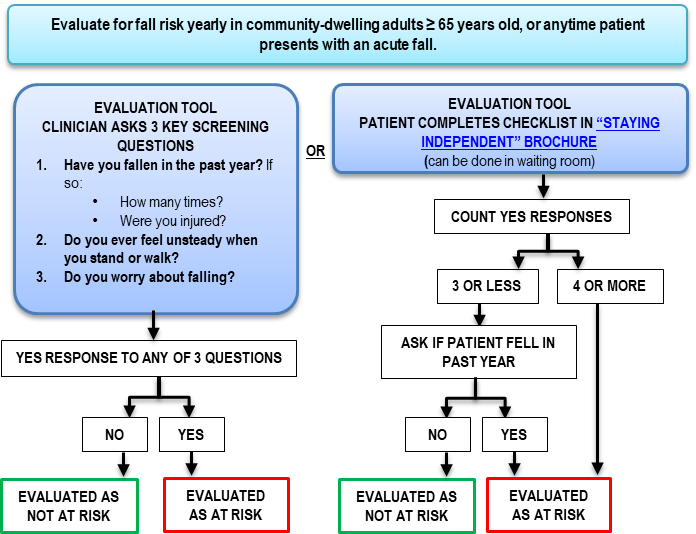An Unbiased View of Dementia Fall Risk
Table of ContentsThe Basic Principles Of Dementia Fall Risk Getting The Dementia Fall Risk To WorkDementia Fall Risk - QuestionsIndicators on Dementia Fall Risk You Should KnowSome Known Questions About Dementia Fall Risk.
The FRAT has three areas: fall risk status, risk aspect checklist, and activity plan. An Autumn Risk Condition consists of information about history of current drops, medications, mental and cognitive condition of the patient - Dementia Fall Risk.If the patient scores on a danger variable, the equivalent number of factors are counted to the client's loss threat score in the box to the much right. If a patient's autumn threat score completes five or greater, the person goes to high threat for drops. If the patient scores only four factors or lower, they are still at some danger of falling, and the registered nurse should utilize their ideal medical evaluation to handle all fall danger variables as part of an all natural care strategy.
These typical techniques, as a whole, help develop a secure atmosphere that reduces accidental falls and defines core preventative steps for all individuals. Signs are vital for people at threat for drops. Doctor require to acknowledge who has the condition, for they are in charge of implementing activities to advertise person security and prevent falls.
Not known Incorrect Statements About Dementia Fall Risk
For instance, wristbands need to include the client's last and first name, date of birth, and NHS number in the UK. Information must be printed/written in black versus a white background. Only red color should be utilized to signal unique person condition. These recommendations are constant with existing advancements in client recognition (Sevdalis et al., 2009).
Products that are as well much may call for the client to get to out or ambulate unnecessarily and can potentially be a danger or add to drops. Aids avoid the person from going out of bed with no help. Registered nurses respond to fallers' phone call lights quicker than they do to lights launched by non-fallers.
Visual disability can significantly trigger falls. Keeping the beds closer to the flooring decreases the risk of drops and serious injury. Positioning the cushion on the flooring considerably minimizes loss danger in some health care settings.
Indicators on Dementia Fall Risk You Should Know
Patients that are tall and with weak leg muscular tissues that try to rest on the bed from a standing placement are likely to fall onto the bed due to the fact that it's too reduced for them to lower themselves safely. If a tall patient efforts to get up from a reduced bed without aid, the person is likely to drop back down onto the bed or miss the bed and drop onto the flooring.
They're created to promote timely rescue, not to stop drops from bed. Audible alarm systems can also advise the patient not to obtain up alone. The usage of alarm systems can likewise be an alternative to physical restraints. In addition to bed alarm systems, enhanced supervision for high-risk individuals also may assist protect against falls.
.png)
Clients with a shuffling gait boost fall possibilities significantly. To reduce loss threat, shoes ought to be with a little to no heel, thin soles with slip-resistant walk, and sustain Home Page the ankle joints. Suggest individual to utilize nonskid socks to avoid the feet from gliding upon standing. Nonetheless, urge clients to use appropriate, well-fitting shoesnot nonskid socks for ambulation.
Some Known Incorrect Statements About Dementia Fall Risk
In a study, homes with adequate lighting report less drops (Ramulu et al., 2021). Renovation in illumination at home might minimize fall prices in older grownups.

Caretakers are reliable for assuring a protected, safeguarded, and safe atmosphere. However, studies demonstrated really low-certainty proof that sitters decrease fall risk in intense treatment healthcare facilities and only moderate-certainty that choices like video clip monitoring can lower sitter use without enhancing fall threat, recommending that caretakers are not as beneficial as originally believed (Greely et al., 2020).
More About Dementia Fall Risk

Increased physical fitness minimizes the danger for falls and limits injury that is suffered when loss takes place. Land and water-based exercise programs may be in a similar way helpful on balance and stride and consequently minimize the danger for drops. Water exercise may add a positive advantage news on balance and stride for women 65 years and older.
Chair Increase Workout is a basic sit-to-stand exercise that aids enhance the muscular tissues in the upper legs and buttocks and enhances wheelchair and independence. The objective is to do Chair Rise exercises without making use of hands as the customer ends up being more powerful. See sources section for a thorough instruction on how to execute Chair Surge workout.